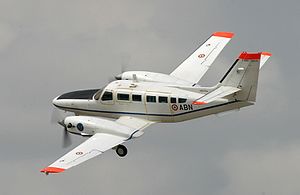Reims-Cessna F406 Caravan II
| F406 Caravan II | |
|---|---|

| |
| A Caravan II of the French Army | |
| Role | Twin-engined utility |
| National origin | France/United States of America |
| Manufacturer | Reims Aviation |
| First flight | 22 September 1983 |
| Status | In service, production to recommence |
| Primary users | French DGDDI Republic of Korea Navy |
| Produced | 1983–2013 |
| Number built | 99[a][1] |
| Developed from | Cessna 404 Titan |



The Reims-Cessna F406 Caravan II is a turboprop twin engine utility aircraft manufactured and designed by Reims Aviation in cooperation with Cessna.
Design and development
The F406 Caravan II is a twin turboprop engined, fourteen-seat low-wing monoplane of conventional aluminium and steel construction.[clarification needed] It is a development of the Cessna 404 Titan with two Pratt & Whitney PT6 turboprop engines. The aircraft first flew on 22 September 1983,[2] and was produced by Reims Aviation until the company's 2013 demise.[3] In 2014, aircraft engine manufacturer Continental Motors, Inc., American subsidiary of the Aviation Industry Corporation of China, partnered with French-based marketer ASI Innovation to purchase rights to the F406; Continental Motors intends to restart production, including a diesel piston engine variant, with marketing to be carried out by ASI.[4][5]
The F406 is aimed at passenger and small cargo transport, and civilian and military surveillance. For extra cargo capacity a cargo pod can be fitted to the belly of the aircraft. The Surmar is a new maritime surveillance version of the aircraft with extra equipment such as a 360 degree radar.
Though the F406 is more expensive to operate than single-engine aircraft of the same passenger capacity such as the Cessna 208 Caravan, having two engines makes it comply with European regulations regarding commercial operations, which only allow multi-engine aircraft for commercial instrument flight.
In March 2014 Reims Aviation was acquired by Chinese-owned Continental Motors Inc and renamed ASI Aviation, two remaining incomplete airframes are finished in France before a probable shift to Mobile, Alabama with new avionics, electrical and hydraulic systems, a new autopilot and an engine choice of current P&WC PT6A-135 or pistons : Continental GTSIO-520 and/or Continental CD-310 diesel.[6] The Type Certificate transferred only had approval to produce spare parts and not the whole aircraft.[1]
Operators
This section needs additional citations for verification. (December 2015) |
- Australia
- Australian Customs and Border Protection Service – Two F406s operated by Cobham Aviation Services Australia for maritime patrols.[7]
- France
- French Army – Two F406s as utility aircraft.
- Directorate-General of Customs and Indirect Taxes – Used seven F406s for maritime patrol activities. From 2012 onwards being replaced by the Beechcraft King Air 350
- Greece
- Hellenic Coast Guard – Received 3 F406s for maritime patrol activities from 2001.[8]
- Mali
- Mali Air Force – Three F406s on order.[9]
- Namibia
- Ministry of Fisheries and Marine Resources – Two F406s for monitoring fishing activity.
- Republic of Korea
- Republic of Korea Navy – Ordered five F406s for use as target tugs in May 1997 with delivery from November 1998.[10]
- United Kingdom
- RVL Aviation Six F406 used in multiple roles (including one operated on behalf of HRMC listed below).
- Department for Environment, Food and Rural Affairs – Two F406s operated by DirectFlight for monitoring fishing activity.
- Her Majesty's Maritime and Coastguard Agency – One F406 for pollution detection, vessel identification and SAR top-cover.
- Marine Scotland – Two F406s for monitoring fishing activity.
Specifications
Data from Jane's All the World's Aircraft 1988–89 [11]
General characteristics
- Crew: One[1]
- Capacity: 12 passengers
Performance
See also
Related development
Aircraft of comparable role, configuration, and era
References and notes
- ^ One prototype and 98 production aircraft
- ^ a b c d e "EASA Type-Certificate Data Sheet EASA.A109" (PDF).
- ^ Taylor 1988, p. 79.
- ^ "GECI Aviation". Retrieved 9 June 2012. Archived March 16, 2012, at the Wayback Machine
- ^ Pope, Stephen (March 28, 2014). "Continental To Build Former Cessna Cabin Class Twin: Engine maker buys type certificate". Retrieved 30 January 2016.
- ^ "Cessna Twin Returns to production in France". AOPA Pilot: 36. June 2014.
- ^ Paul Jackson (May 23, 2016). "Props And Turboprops About To Enter The Marketplace". Aviation Week Network.
- ^ Cobham Receives AUD$ 7 million Additional Contract Extension from Australian Customs and Border Protection Service, article retrieved 23 July 2013.
- ^ "Airscene: Military Affairs: First Hellenic Coast Guard F406 enters service". Air International, Vol. 60, No. 5, May 2001. p. 262. ISSN 0306-5634
- ^ Hoyle Flight International 8–14 December 2015, p. 43.
- ^ "Airscene: Military affairs". Air International, Vol. 56, No. 1, January 1999. p. 3.
- ^ Taylor 1988, p.80.
- ^ Indicated Air Speed.
- ^ Max cruise, 45 min reserves
- Hoyle, Craig. "World Air Forces Directory". Flight International, 8–14 December 2015, Vol. 188, No. 5517. pp. 26–53.
- Taylor, John W.R. Jane's All The World's Aircraft 1988–89. Coulsdon, UK:Jane's Defence Data, 1988. ISBN 0 7106-0867-5.
